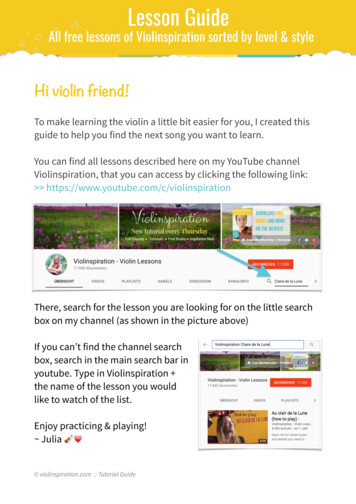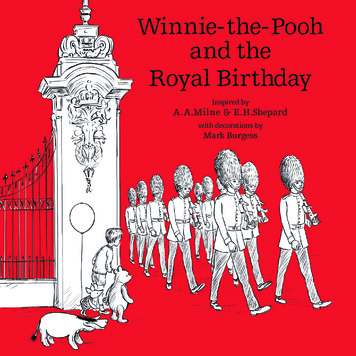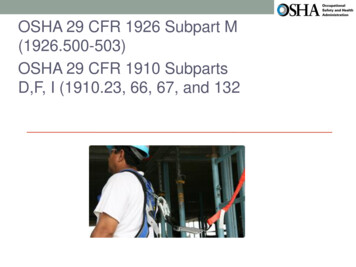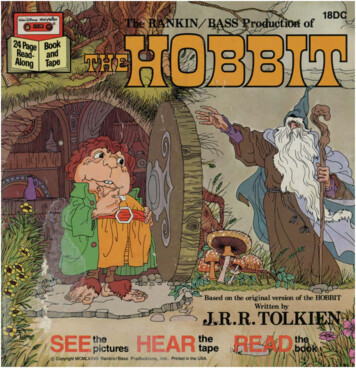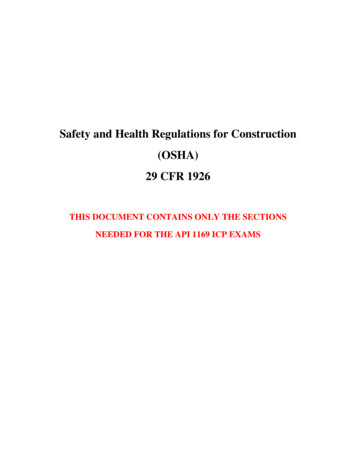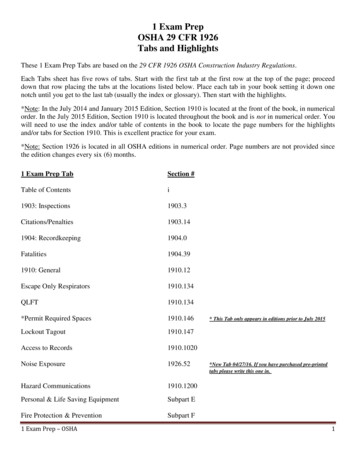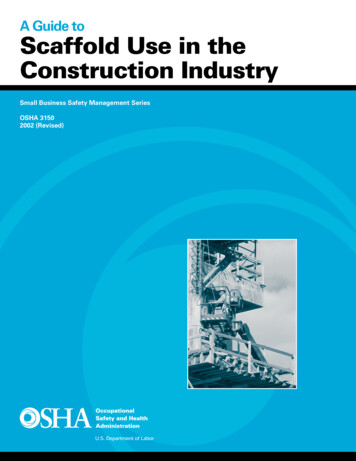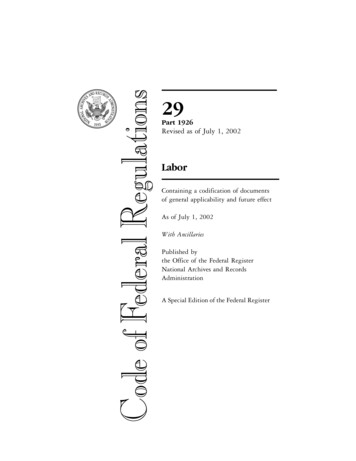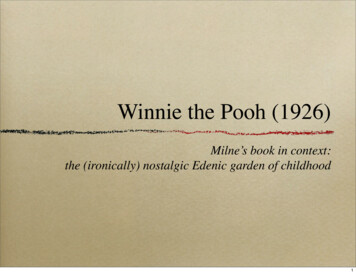
Transcription
Winnie the Pooh (1926)Milne’s book in context:the (ironically) nostalgic Edenic garden of childhood1
From Carroll to Milne: fromVictorian to Edwardian EnglandDuring the second half of the 19th Century smallfamilies were coming into fashion among middleclass families:medical emphasis on the debilitating effects ofbearing too many children on a woman’s healthincreasing knowledge of birth controlincreasingly widespread feeling that one’s childrencould have better opportunities if there were fewerof them to feed, clothe etc.2
The demographic change: theexample of Children’s authorsEdward Lear (b. 1812): the youngest of 20childrenC. L. Dodgson (b. 1832): the eldest son of 11childrenBeatrix Potter (b. 1866): one of two siblingsA. A. Milne (b. 1882): one of three sons, andeach of them in turn father of one child only3
The fashion for smaller familiesand the cult of the childParents had more time and money todevote to their children’s needsCloser attention was lavished to theworld of childrenMore interest in ‘childish’ things: childbooks, clothes, toys etc.Rise of the industry of children’scommodities4
The myth of the‘beautiful child’1886: Frances HodgsonBurnett publishes the novelLittle Lord Fauntleroy, whichestablishes the fashion forlaces, collars and long curls5
Milne and the beautiful child.The Milne FamilyMilne’s son in Whenwe were very young6
Winnie the Pooh and the lovablechild“Oh, Bear!” saidChristopher Robin, “Howdo I love you!”“So do I”, said Pooh“You’re the Best Bear in theWorld”, said ChristopherRobin sootingly.“Am I?” said Poohhopefully.7
Alan Alexander Milne (1882-1956)A very happy childhoodamong other boys (hisfather was in charge of apublic school)Educated at TrinityCollege, Cambridge(third-class degree inmathematics)1906: assistant of Punch8
Alan Alexander Milne (1882-1956)1915: though a pacifist, heenlists for war service (theninvalided home from theSomme with trench fever)1920: birth of ChristopherRobin, his only childMilne ‘enraptured’ by his sonmoves to a country retreat inSussex (a model for Pooh’sforest)9
Alan Alexander Milne’s workWhen we were veryyoung (1924, poems)Winnie the Pooh (1926)Now We Are Six (1927,poems)The House at PoohCorner (1928)10
Milne and the success of the PoohstoriesThe Pooh books were immenselypopular (40,000 copies sold inEngland after six weeks)However, Milne’s later career as adramatist was not successfulHis son’s resentment: “It seemed tome, almost, that my father had gotto where he was by climbing uponmy infant shoulders, that he hadfilched from me my good name andhad left me with nothing but theempty fame of being his son”11
Winnie the Pooh: childhood asnostalgiaAfter the first World War, there is adecline in children’s fantasiesDisillusion about middle-classcertaintiesWith this respect, Milne’s Pooh storieslook back nostalgically to an Edenicconception of childhood. but are also shot through withmockery of the very idyll they areoffering12
Winnie the Pooh: a ‘realistic’Arcadia?In Winnie the Pooh, we find again thesymbolism of the gardenBurnett’s Secret Garden: a place ofprotection but also of ‘magic’: as Marytends the garden and weeds away theundergrowth, her cousin re-gains hishealthIn Milne’s book, the garden is the cosy,middle-class space of idyllic seclusionfrom the world13
Edwardian Parodies of the Mythof the GardenBeatrix Potter (also her stories are setin a ‘perfect garden’ but:)“But don’t go to Mr McGregor’sgarden; your Father had an accidentthere; he was put in a pie by MrsMcGregor.”T. S. Eliot, The Waste Land (1922) asthe most famous overturn of thebeautiful garden; The Four Quartets14
Winnie the Pooh: a ‘realistic’Arcadia?The ‘original’ toys ofMilne’s son ChristopherRobin15
Winnie the Pooh: a ‘realistic’Arcadia?Where Carroll invented a wild and chaoticWonderland, Milne is much more ralistic:his characters are middle-classhousehold commodities (toys fromHarrods!)the garden is modelled on Milne’s Sussexgardenalso children are depicted as they are16
Milne: Victorian and EdwardianThe Pooh stories show a cleverjuxtaposition of two worlds:Victorian non-sense and fantasythe Edwardian myth of the ‘idyllic ruralEngland”the result is a kind of tamed( domesticated) nonsense brought into theworld of everyday17
Milne’s idea of childhoodMilne rejects the Wordsworthian view of childhood.“Preface to the Parents”:very young children possess an ‘artless beauty’that mistakes parents into thinking that “Heaven[.] does really [.] lie about the child”but children’s beauty is accompanied by “anatural lack of moral quality, which expressesitself, as Nature always insists on expressingherself, in an egotism entirely ruthless”18
Children as self-centeredThe ‘realism’ of the Pooh stories isvisible also in the representation ofchildren’s attitude and behaviour.Children are not just idealized, realismcalls for the representation of children’sfaults as well.19
Childlike Selfishness in the PoohstoriesEvery character personifies one type ofselfishness:Pooh: puts his appetite for honey beforeeverythingPiglet: only concerned to save his own skinEeyore: self-pity taken to extremesRabbit: business-mindedOwl: self-respect for his (nonexistent) cleverness20
Adults and children in W-t-PThe narrator is intrusive but affectionate, nostalgiccontemplation of childhood:The end of Pooh Corner: “Somewhere, a little boy and his bearwill always be playing!”The end of James Barrie’s Peter Pan (1911): “As you look atWendy, you may see her hair becoming white [.]. Jane is nowa common grown-up, with a daughter called Margaret; andevery spring cleaning time, except when he forgets, Peter comesfor Margaret and takes her to the Neverland, where she tellshim stories about himself, to which he listens eagerly. WhenMargaret grows up she will have a daughter, who is to bePeter's mother in turn; and thus it will go on, so long aschildren are gay and innocent and heartless.”21
Adults and children in W-t-PChildlike characters: Pooh, Piglet, Roo, (Tigger)Adult-like: Christopher Robin, Kanga, Owl, Rabbit,EeyoreHowever, the status is not fixed for all thecharacters:Christopher Robin is often adult-like (a ‘deus exmachina’) but the narrator makes clear he is achildPooh: a child with respect to CR but a parentwith respect to Piglet22
Winnie the Pooh: a ‘realistic’ Arcadia? In Winnie the Pooh, we find again the symbolism of the garden Burnett’s Secret Garden: a place of protection but also of ‘magic’: as Mary tends the garden and weeds away the undergrowth, her cousin re-gains his health In Milne’s book,
